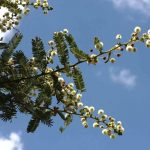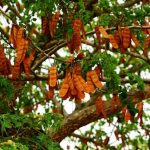TREE LIFE
June 1987
MASHONALAND CALENDAR
Saturday June 6th : Botanic Garden Walk. Tom will continue our discussion of the Zambezi Valley vegetation. We hope to consider the Jesse bush which grows on the Aeolian Kalahari Sands. Meet at the car park at 1045 hours for 1100 hours.
Sunday June 7th : The Ayshire branch has invited us to join them in exploring another beautiful riverine site on Glen-a-el Farm. The last visit was a most rewarding one with spectacular riverine forest . The party will depart from the Ayrshire Rural Council Offices at 0930 hours. For further information contact either Gill Henderson at Raffingora 3113 or Kim Damstra at Harare 84419.
Sunday June 21st : A return visit to Alamein Farm, Beatrice. There was so much we missed on our last rainy outing to Alamein we would really like to return. We will plan once again to spend the morning in the mopane with the Combretum imberbe, and Combetum hereroense and Cassine transvaalensis. Perhaps we will see Strychnos pungens in fruit, and here is a challenge to all the tree growers, this is a species which Tom has not been able to germinate to it does not occur in the Gardens!
Saturday June 27th : A pleasant stroll in the Mukuvisi Woodlands. Meet at 1500 hours at the corner of Paget Road and Inyanga Crescent.
MATABELELAND CALENDAR
Sunday June 7th : we will go to the Matopos, the Honeyguide Highway area. Meet at Retreat, 0830 hours. Bring lunch, as this will be a day excursion.
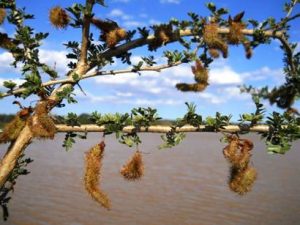
Ormocarpum trichocarpum. Photo: L. E. Lauritsen. Source: Flora of Zimbabwe
On Sunday 3rd May we went to the area of Old Bulawayo, (Lobengula’s establishment of the 1870’s) and also to the former Jesuit Mission nearby which was the first Roman Catholic Church in this country. We found some 50 tree species, a lot of Acacia karroo, some still flowering and many with seed pods that were sickle shaped but much more constricted than usual, more like Acacia nilotica. Perhaps this was due to the exceptionally dry season. Acacia nilotica was also widespread in the area and there were quite a few Acacia robusta. We found many Rhus tenuinervis as well as some Rhus pyroides too, several Berchemia zeyheri, Brachylaena rotundata, far from rotund, quite pointed in fact, Euclea divinorum, E.natalensis,, E.undulata, in fairly thick clumps, a lot of Carisa edulis, Cassine matabelica, C.transvaalensis, Catha edulis, one Celtis africana, Cussonia natalensis, Dichrostachys cinerea, Diplorhynchus condylocarpon, Diospyros lycioides, Dovyalis caffra, almost thorny enough to be Scolopia, Faurea saligna, Ficus thonningii, 3 species of Maytenus, M.heterophylla, M.senegalensis and M.undata with white powdery bloom, Ormocarpum trichocarpum with many hairy caterpillar pods, a very small Protea gaguedi some Erythrina latissima with leaves a bit smaller than usual, Schrebera alata very green and leafy compared to most trees seen on this day, Tapiphyllum velutinum, a largish Ximenia americana in fruit, Ximenia caffra and some fair size Zizyphus mucronata. Generally many of the trees had smaller leaves than usual and we wondered whether this was because of dry poorer soil or the weather we have experienced lately, probably both.
-C.Sykes
THE 37TH A G M HELD AT SPEY BEY, RUWA, SUNDAY 17TH MAY 1987
We are indeed indebted to Mrs. Teunon for allowing us to invade her beautiful garden which proved to be a superb setting for the AGM.
CHAIRMAN’S REPORT :
It is 14 months since the last AGM on the lawns of Gletwyn. During these months the Society has been so active that it has been difficult keeping a record to send out with the newsletters, and often my other responsibilities have been neglected. As a chairman I have welcomed the ever greater workload which the committee has accepted, particularly in connection with the newsletter. Every member of the committee has been inveigled into playing some role along the line and so on behalf of the Society I offer my thanks to them all. Expressing our gratitude to the typists at Duplicating Services is long overdue. Their welcoming office has the happiest of memories which are naturally coloured by the fact that at that stage the newsletter is written and my role over for another month. When Vida took over as Membership Secretary my workload was reduced even further and this role is now performed with greater efficiency than before. The committee’s teamwork has been so well coordinated it is not practical to enumerate the virtues of the individual members, but their continued support through a difficult year has been gratefully appreciated.
So what has the Society achieved and in what direction are we now facing? In the past year we have increased our familiarity with the Zambezi Valley. In April 1986 when I was reined in at A-camp while teaching for the Mashonaland Hunter’s Association, an energetic party that included Bob Drummond from the Herbarium set off by boat from Chirundu to Ruchomechi. The knowledge gained from this trip proved invaluable when the Society was invited to address the Zambezi Society Workshop on the Zambezi River System held at Mana Pools earlier this month. The checklist which Meg presented to this Workshop was so well received that there are now plans to expand it into a colour leaflet. We must be alert to the danger of losing some of the Valley floor to resettlement, particularly with the increasing pressure on land and the eradication of the tsetse fly. I believe that increasing the educational potential of the Valley, and re-educating the public to broaden their field of view to include the vegetation is and will continue to pla an important role in the justification of its continued preservation as a wildlife area. The close cooperation that now exists between the Tree Society, the Zambezi Society and the Hunter’s Association is an ideal environment in which to continue to pursue this goal.
Scholars should never be under estimated. In the Valley they soon get their tongues around names like Combretum eleagnoides and Acacia ataxacantha, particularly when travelling at speed along overgrown tracks where the latter cry becomes second nature. The problem that scholars face though lies in finding easily accessible information. During the past year the Society assisted in the naming of trees along trails through Gosha Park, the Peterhouse School Conservation Area near Springvale. Together with the Bulawayo Branch we visited the Falcon College Conservation Area where the students and staff have already prepared an excellent field card for the trees. We were able to build on this foundation by providing more information and thus help stimulate further interest.
Closer to home we have increased our involvement with the Mukuvisi Woodlands. We helped plan a new nature trail which I feel addresses the more important aspects of conservation. Meg has spent many hours developing a workable key to all the trees and shrubs in the woodland and Society members have responded well to cries for help in testing early drafts of the key. The latest workshop, which consisted of 20 Bed students from the University, demonstrated the exceptional value that this keep can have in secondary education. We firmly believe that education and interest in our indigenous woodland is the key to its long term conservation.
The growing of indigenous trees and conservation of woodland for utilization by local inhabitants is a topic of national importance. The desire for further information is so acute that it is difficult keeping up with demand. As part of a co-operative relationship with the Association of Women’s Clubs and the Rural Afforestation I addressed a three day workshop dealing with Rural Afforestation and village woodlots for both exotic and indigenous trees. The keen desire for information is only too obvious; we need to find more time to document what is already known.
Meg presented a five hour session on growing indigenous trees to a combined workshop arranged by the Curriculum Development Unit of the Department of Education and the Department of Forestry in Mutare. This workshop was directed at selected educationalists from throughout the country and was also attended by the headmaster and staff of the forestry college in Mutare. The full programme that Meg organized kept both of us running but proved how invaluable education is in achieving conservation. It also demonstrated the importance of local plant names as common names and the lack of documentation on the many local names that are not included in Wild’s dictionary. This programme is now in great demand for future workshops.
The Society’s outings have come under attack as being “picnics’ and as a picnic is defined in the Oxford Dictionary as a “pleasure excursion including outdoor meal” then picnicking is definitely something we do. I feel very strongly that these outings play a most essential role in our education programme. In order to educate others we must pass on our own enthusiasm for the local woodland. This enthusiasm must be based on knowledge so we must continue to educate ourselves. These excursions also provide the greatest backing for our conservation policy. Why do we want to conserve woodland? Because we can see what a great pleasure it gives us.
On our excursions during the past year we have sharpened our awareness of the geological formations that underlie the changes in vegetation. We have explored one of Zimbabwe’s most unique landmarks, the Great Dyke. In April ’86 the visit to Kilmacdough Estate showed that although the Serpentine on either side of the Dyke is toxic to many species and has a number of endemics, the Pyroxinite in the centre supports a high diversity with many unusual species along its rivers. This was confirmed in July when we examined the Dyke immediately downstream from Darwendale Dam. Earlier this year some of us had the privilege of seeing the northern most edge of the Dyke where it gives way to the Zambezi Valley and where we found numerous specimens of the uncommon Ochna gambleoides. During September the Dyke treated us to a magnificent display of Bolusanthus speciosus in full flower near Selous and in October we visited Wedza Mountain. This isolated outcrop of Serpentinite and associated rocks is a botanical rarity.
Working on the granites and gneissic rocks of the Basement Complex we have examined the diverse woodland below Mwengi Dam near Darwendale and revisited Ivordale Farm in the Enterprise Area. The trip beyond Makumbi Mission showed us the great diversity and spectacular woodland within this rural area the Leatt’s farm in Concession and Carolina Estate near Lake MacIwaine showed that although the granites are characterized by poor soils, they can support a remarkable diversity particularly amongst the rocks.
The broad expanses of granites and gneisses are framed by strips of Greenstone which provide a diverse array of sometimes fertile soils. Who can forget the September outing to the Jasperite outcrops at Usasa Farm, Chegutu, with tall Haplocoelum, or the riverine vegetation at Christon Bank which we visited in March 1987. Then again what about the Cordia on Woodlands Farm in Shamva which we found in full flower in Aril 1987. Moving on to a different soil type we spent a rainy day on Alamein arm in Beatrice.
The Branches have also been very active this year. The Bulawayo Branch meets regularly and successfully hosted two excursions from Harare. Amongst their members there is a fund of invaluable knowledge which makes them such excellent teachers. Once again this comes back to their regular outings which sharpen their interest and increase their awareness. The enthusiastic Chegutu crowd always welcome visitors from Harare and the recent interest from farmers in Centenary has been most welcome. The Ayrshire community continue to maintain their interest in keep contact.
This report has been a very brief overview of some of the Society’s activities during the past very active year. My two terms of office are now over and as I hand over to a new chairman and step off the Committee completely I would like to wish them all the best for the future. I feel the Society is in good hands and encourage the committee to be receptive to changes within the Society. New and different approaches help to revitalize the Society and keep it ahead.
-Kim Damstra
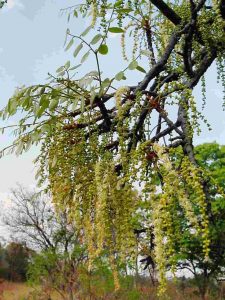
Burkea africana. Photo:Mark Hyde. Source: Flora of Zimbabwe
BOTANIZING AT SPEY BEY, RUWA : We are most grateful to Mrs. Teunon for allowing us the pleasure of sharing her garden with us. The late Mr. Teunon was obviously a great lover of nature and of gardening. He constructed the dam at the bottom of the garden and the Willow Pattern bridge that sweeps across it. The rolling lawns and the rockery must have taken many hours of hard work. The most impressive feature is the way the garden has been constructed around the spectacular indigenous trees. These specimens may always have been exceptionally large, but I am sure the care and attention lavished on the garden has also helped. We held the AGM beneath a musasa and Mukurati, Burkea africana. The trunks of these two species were so covered in lichens that they were indistinguishable from one another. Alongside were two large Faurea saligna and a stately Steganotaenia. We so often find saplings of this latter species it is rewarding to see an adult.
I recently met a fellow cyclist with a bundle of Steganotaenia branches tied onto his carrier as presents for his family. So plastic Biro pens have not entirely replaced these natural popguns.
Spey Bey is situated on granite which generally weathers away to form a poor sandy soil. Although we often botanize on granite the trees here seem to be different. The leaflets on the musasa were smaller and more elongate than usual and we argued over a Boscia salicifolia that had small leaves which stuck out like those on a bottle brush. When we eventually picked the leaves we saw the distinct midrib and lack of the pellucid dots that characterize the bottle brush.
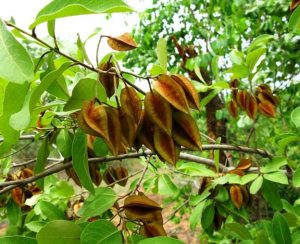
Combretum collinum. Photo: Helen Pickering. Source: Flora of Zimbabwe
Another species we have come to associate with sandveld is Combretum collinum and here there were a number of fine specimens illustrating some of the variability. One specimen had a thick velvety undersurface to the leaf whereas in other specimens the undersurface was simply covered in white scales. Passing a small Azanza garckeana covered in green snot apples we headed for the dam wall where we found a magnificent Ochna pulchra, Cussonia arborea, a number of Mundulea sericea, a tall Erythrina abyssinica, a Pterocarpus rotundifolius leaning over the stream, plenty of Ficus thonningii and an anthill covered in Ehretia obtusifolia. The latter may have been a single multi trunked individual but the termites had covered up so much of them they appeared to be a grove of individuals. Alongside the Ehretia was a large Rhus longipes covered in the flattened fruit so characteristic of the genus.
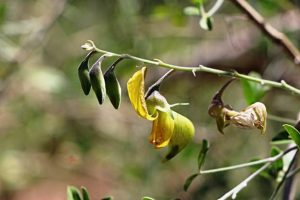
Crotalaria pallidicaulis. Photo: Mark Hyde. Source: Flora of Zimbabwe
The rockery boasted tall delicate Crotalaria pallidicaulis and Pterocarpus angolensis but the Ekebergia benguelensis were most noticeable as their leaves had turned a brilliant red. Albizia antunesiana and Diplorhynchus condylocarpon grew alongside the path with smaller specimens of Tarenna neurophylla and a mystry Rhus. Psydrax livida, Canthium huillense, demonstrated that typical RUBINCEAE feature of having glabrous individuals growing side by side with furry leaved individuals. A little further on a Ficus thonningii had germinated in the branches of another tree and the numerous aerial roots were busy forming a cage around its trunk. Beneath this was a Euclea natalensis with a dense coating of a thick black pile along the undersurface of the leaf. We could not decide on what had caused this strange growth. A few small Parinari grew in the shade.
Moving over to what appeared to e a large termitarium we saw Combretum molle and a large Pappea capensis that demonstrated both the serrated and entire leaf margins. A tall fine leaved tree set us thinking for a while. No thorns could be seen but the alternatives were either Acacia sieberiana or Albizia amara. The pods were very old and dehydrated but theseeen showed the horse shoe patter characteristic of Acacia.
Alongside the garage we found the mystery Rhus once again and a fine Ochna puberula. But despite diligent searching we were unable to see the hairs that Bob always seems to see. After noting the inverted cone shape so characteristic of Pterocarpus angolensis we headed towards a grove of exotics that included oaks, Quercus robur, and Fraxinus. This latter belongs to the olive family and has opposite imparipinnate leaves. It is interesting to compare these leaves with our indigenous Lecaniodiscus fraxinifolius. The similarity is very superficial as Lecaniodiscus has alternate paripinnate leaves.
It really was very special to be able to see such a wide range of species each represented by fine specimens, and to have seen all these as well as completing the AGM and sharing a sumptuous tea is quite an achievement. We really are deeply indebted to Mrs. Theunon for her splendid hospitality.
The afternoon walk over the bridge and to the wilder part of the farm was equally rewarding but unfortunately I needed to return to mark practicals. On the recce we had seen Cassine transvaalensis on an anthill and a large Vitex payos amongst the rocks.
-Kim Damstra
In the May Botanic Garden Walk Tom dealt with the alluvial vegetation at Mana Pools. These notes are being compiled as a road guide to the Park and will be published when ready.
KIM DAMSTRA CHAIRMAN


